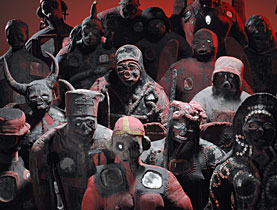
Voodoo casts spell on Geneva

Voodoo, the traditional religious cult, has a hard time shaking off its dark Hollywood-driven clichés of flesh-eating zombies, pin dolls and devil worship.
In a bid to rectify this image, the Museum of Ethnography in Geneva is holding an exhibition of some 300 Haitian voodoo objects, part of the largest collection of its kind, owned by a Swiss woman living in Haiti’s capital, Port-au-Prince.
Haiti is one of the poorest nations on the planet, but the tiny Caribbean country, which threw off its chains to become the first-ever black people’s republic in 1804, is rich in many other ways.
“Voodoo – a way of life” is a testament to the vitality of Haitian voodoo, the primary culture and religion of some seven million people.
But lifting the lid on this complex, little-known cult, which is an ocean apart from ours and which refuses rational classification, is no small order. How do you display the invisible?
“When you try to explain voodoo it escapes us – that’s its most defining characteristic,” curator Philippe Mathez told swissinfo.
“When you unwrap voodoo, a great mishmash of ideas tumbles forth and collides – images of freed slaves, Hollywood zombies and Taino Indians.”
The exhibition is therefore an invitation to the visitor to plunge into this “dreamlike world of sensorial experiences”, added Mathez.
Mysterious journey
The step-by-step voyage begins with a solitary empty perfume bottle and the poem “Le Flacon” by French poet Charles Baudelaire. The metaphor of strong fragrances that cannot be contained by porous glass hints at the hidden mysteries ahead.
Next, a huge sealed wooden chest straight out of an Indiana Jones film, used to transport the artefacts from Haiti, and little by little the island treasure is unwrapped and the enigma is revealed in its full complexity.
Wooden painted statues topped with human skulls, ornate wall hangings and huge horned mirrors stand alongside delicate clay Indian figures of magicians, decorated bottles of rum and colourful sequined plastic dolls.
The progressively darker journey ends with a spectacular room full of life-size figures from one of Haiti’s secret voodoo societies – the bizango.
Swiss collector
The exhibition is part of a collection owned by Marianne Lehmann, a retired Swiss civil servant, who has lived in Haiti since 1957.
Since her move there, she has amassed over 3,000 artefacts, one of the largest collections of Haitian sacred art in the world.
“Voodoo is often misunderstood,” she told swissinfo in an interview in 2001. It became a positive symbol of freedom for slaves during the colonial era, when the newly arrived colonialists “tried to impose Catholicism on the people in a very ruthless manner”, she said.
Under the plantation system, secret ceremonies took place celebrating the slaves´ sense of identity and resistance. Voodoo priests were among the ringleaders of the 1791 revolution on the island, which has been described as the only successful slave revolt in history.
In 1985, voodoo was formally recognised as a legitimate religion in the Haitian constitution.
Lehmann´s own interest in voodoo began when a travelling salesman visited her office at the Swiss consulate, saying he had a rare object for her.
“As soon as I set eyes on this smallish, really quite crudely made statuette, smoking a pipe, it was like a current of electricity passed through my body,” Lehmann recalled. “It seemed to look at me so maliciously.”
She managed to make contact with voodoo priests, who would occasionally sell off their statues and dolls when they needed money for medical treatment, or to send their children to school.
Lehmann has since set up a foundation to manage the collection as a “gift to the people of Haiti”, with the ultimate aim of building a museum in Port-au-Prince.
In so doing she hopes to illustrate voodoo’s richness as an integral part of Haiti’s troubled history and culture.
swissinfo, Simon Bradley in Geneva
The Republic of Haiti is located on the western third of the island of Hispaniola in the West Indies. It has a population of 8,122,000 and its capital is Port-au-Prince. Almost the entire population is of African or African-European descent.
The word voodoo or vodou, derives from vodũ, which in West African dialect means spirit or divine creature. Anthropologists estimate the religion to be 6,000-10,000 years old.
Voodoo – a way of life runs at the Museum of Ethnography in Geneva until August 31.
Haitian voodoo, or vodou, is an officially recognised religious tradition practised throughout Haiti. It combines theological and magical elements of African religions and rituals, imported from West Africa via African slaves, and influences of Roman Catholicism and native Taino Indians.
Haitian vodou is very similar to other Afro-based faiths such as Santeria, practised in Cuba and Puerto Rico, Espiritismo in Dominican Republic, Obeah in Jamaica and Candomblé in Brazil.
Practitioners claim they believe in a supreme God, but focus more on a large number of spirits called the loa, which are local or African gods, deified ancestors, or Catholic saints.
The loa demand ritual service and attach themselves to individuals or families. In turn, they act as helpers, protectors, and guides.
In serving the spirits, followers seek to achieve harmony with themselves and the world around them, which is transformed into personal power and resourcefulness in dealing with life.
In ritual services, a priest or priestess leads devotees in ceremonies involving song, drumming, dance, prayer, food preparation, and animal sacrifice. The loa possess worshippers during services, passing on advice, performing cures, or displaying special physical feats.

In compliance with the JTI standards
More: SWI swissinfo.ch certified by the Journalism Trust Initiative




























You can find an overview of ongoing debates with our journalists here . Please join us!
If you want to start a conversation about a topic raised in this article or want to report factual errors, email us at english@swissinfo.ch.